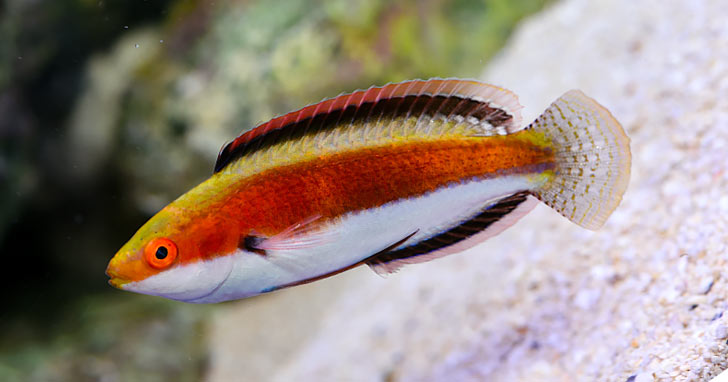
Introduction to Reef Safe WrassesWhy wrasses for your aquarium?
If you are looking to add a flash of color, lively movement and a fish of interest to your reef aquarium look no further than a wrasse. Wrasses belong to the second largest family of fish (Gobies being the largest) so there is no shortage of "Reef Safe" wrasses to consider when stocking your reef aquarium. Some of the most popular genus of reef safe wrasse include Cirrhilabrus and Paracheilinus. Fairy Wrasses of the Genus Cirrhilabrus
Members of the genus Cirrhilabrus are commonly referred to as "Fairy Wrasses" and typically average about 5" in length with approximately 60 scientifically described species. Some of the more popular Fairy Wrasses include the Scott’s Fairy Wrasse (Cirrhilabrus scottorum), Labout’s Fairy Wrasse (Cirrhilabrus labouti) and the Lineatus Fairy Wrasse (Cirrhilabrus lineatus). Flasher Wrasses of the Genus Paracheilinus
Representatives of the genus Paracheilinus are known as "Flasher Wrasses" due to the male wrasse’s tendency to brightly display or flash their colors and flare their fins during mating rituals or territorial disputes. Flasher wrasses average about 3" in length with roughly 60 scientifically described species. Revered and sought-after species include the Carpenter’s Flasher Wrasse (Paracheilinus carpenteri), McCosker’s Flasher Wrasse (Paracheilinus mccoskeri) and the Filamented Flasher Wrasse (Paracheilinus filamentosus). Since new species of each genus are still being discovered, and some species reclassified, the number of species for both genera is sure to increase. Other Popular Reef Safe Wrasses
A few other reef safe wrasses worth noting include members of the genus Halichoeres, Pseudocheilinus, and Macropharyngodon. Exercise caution with certain species of Halichoeres wrasse such as the Melanarus Wrasse (Halichoeres melanarus) since particular individuals may develop an interest in small invertebrates including desirable ornamental crustaceans and may nip at or try to eat them. We like to say reef safe "With Caution" for species like Melanarus Wrasse. Depending on the situation, this interest in invertebrates can be advantageous as some members of this genus can help eliminate pyramid snails, which are harmful to Tridacna Clam species, as well as other "pests" including fire worms and flat worms. A number of Pseudocheilinus species are also good stewards to the aquarium and will also help eradicate the aforementioned aquarium pests. These species include but are not limited to the Mystery Wrasse (Pseudocheilinus ocellatus), Four Line Wrasse (Pseudocheilinus tetrataenia), and the Six Line Wrasse (Pseudocheilinus hexataenia). Leopard Wrasses, or members of the genus Macropharyngodon, such as the Vermiculate Leopard Wrasse (Macropharyngodon bipartitus) are beautiful additions to the reef aquarium. Unfortunately, they are not the hardiest group of wrasses to keep, and their care requirements often demand the skills of an expert level aquarist. Keeping Leopard Wrasse species can often prove difficult in the reef aquarium. All species of Leopard Wrasse do best in an aquarium with a healthy layer of soft sandy substrate in which they can burrow and hide. What sort of care do reef Wrasse need?
Wrasses are very active and lively. Be sure to give them as much space as possible, especially when keeping multiple species. Mixed genera and species of wrasses can be kept together with proper planning and research. Avoid housing two males of the same species together since they will inevitably battle, harm, and potentially kill each other. This outcome is also possible with two males of similar looking species such as a Carpenter’s and McCosker’s Wrasse. Since Carpenter’s and McCosker’s Wrasses are similar in appearance, they may possibly view each other as rivals and spar. A tank size of 50 gallows is a recommended as a minimum. To maximize best results when keeping multiple wrasses in the same aquarium, it is best to introduce them in groups which will help disperse aggression from other wrasses or fish that are already established in the aquarium. Wrasses can be territorial just like freshwater cichlids so you can employ the same tactics for introduction. Begin by turning off the aquarium lights, rearrange the aquascape to break up established territories, and feed the tank simultaneously with the release of the new fish to help distract current residents. Or employ the use of a tank divider or acclimation box. As mentioned previously, wrasses are active swimmers and should be fed at least two times a day minimum. Wrasses will thrive if they are fed small amounts of a mixed diet three or even four times daily. Enriched brine shrimp, mysis shrimp, prepared marine diets and quality marine pellet foods should be offered to ensure proper nutrition and optimal health. One of the best tips for keepers of any wrasse species is loss prevention. Be sure your aquarium has a tight-fitting cover or lid since wrasses are notorious jumpers. Most DIY covers are low profile and will not affect the overall aesthetic of a magnificent display or rimless aquarium. Conclusion
With proper planning and research, wrasses can elevate your reef aquarium to the next level with their color, pattern, interesting behaviors and lively activity. Hopefully you have gleaned some information here that will help you with selection and/or compatibility. For "Quick Stats" about certain wrasse species be sure to reference the chart included on each species description page. Related Articles
|
|
|


